Jigsaw puzzles from Japan
Dragons
The dragon here is the mythical beast from China, not the lizard-like figure of Western imagination, but more a snake with legs and whiskers. And where do Chinese dragons come from? There is a gorge called Longmen ("Dragon-gate") on the Yellow River that flows so fast it is said that any carp that managed to swim up it will turn itself into a dragon, the King of the scaly beasts.
This page also includes portrayals of the dragon facing its arch-rival the tiger...
On this page: The dragon - Tiger and dragon
Separate page for tigers on their own
The dragon
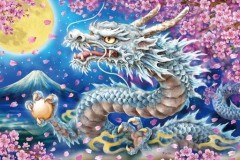 © Epoch 2016: Cherry dragon (Kayomi)Even a dragon can look kind-hearted when portrayed by Kayomi, yet this one displays its scaly jaws and claws, with the magical cintamani jewel in its grasp. Cherry blossom, Mount Fuji, and the full moon complete the picture. No biographical details available. She signs her given name Kayomi in Roman letters.
 In stock In stockAn Epoch puzzle: 2016 pieces; 750 x 500 mm (30" x 20") Code: E22601 (22-601 on package) Retail price ¥3364 (approx. US$23.20 €21.43 £17.99) All about ordering (please read first)
|
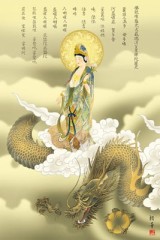 © Hojo Yuka / Sankoh 1000: Kannon rides the DragonA very matronly Kannon, the Goddess of Mercy, stands barefoot amidships on a rather nice dragon. In her left hand she holds a flower (perhaps a lotus flower), while the dragon similarly clutches the symbolic Chintamani Stone (or "treasure ball"). This is a standard pose for Kannon, and this version is subdued in tone yet full of details. The image also includes a complete sutra for the elimination of disasters — this is essentially in Sanskrit transliterated into ancient Chinese, so a typical Japanese reader can make no more meaning of it than you can. Although Kannon is often known as "Goddess of Mercy", experts in Buddhism tell us she is really Avalokitêsvara, who was a man...  In stock In stockAn Appleone puzzle: 1000 pieces; 500 x 750 mm (20" x 30") Code: A10676 (1000-676 on package) Retail price ¥3000 (approx. US$20.69 €19.11 £16.04) All about ordering (please read first)
|
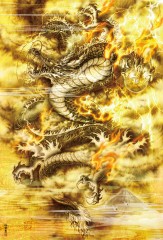 © eshi-masa 1000: Golden dragon (eshi-masa)Although a couple of auspicious symbols are included at the bottom, Mount Fuji and a flight of cranes, this dragon looks tortuously angry and writhing. It will make a tough puzzle! Self-described as a "dragon painter", this artist uses a brush name, styled as eshi-masa, an imaginative combination of characters meaning something like "picture-lion-master". After working as a product designer for Toyota, he set up his own company in 1999, and has since been producing artwork in a range of genres.  In stock In stockA Beverly puzzle: 1000 pieces; 490 x 720 mm (19" x 28") Code: B61462 (61-462 on package) Retail price ¥3300 (approx. US$22.76 €21.02 £17.65) All about ordering (please read first)
|
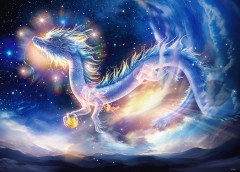 © Takaki 600: Blue Dragon (Takaki)A fantastic dragon indeed, but this one shows rather clearly the shape of the Chinese dragon's body. It is not like a giant lizard, but rather a snake with legs that can fly. And of course it holds the magic Cintamani ball in one claw... Born in Hokkaido in 1974, as a child the artist Takaki was fascinated by birds, so wings feature in many of her images. She became a protégée of Kagaya, and has produced many fantastic images.  In stock In stockA Beverly puzzle: 600 pieces; 530 x 380 mm (21" x 15") Code: B600Z007 (600-007 on package) Retail price ¥2600 (approx. US$17.93 €16.56 £13.90) All about ordering (please read first)
|
 © Harai Kayomi / Studio Oz 420: Double dragon (Kayomi)A pair of dragons make fearsome adversaries. But in Buddhist-inspired mythology, they are not seen as evil, rather as symbols of right. Here each dragon has one claw extended as if to fight, but in the other holds the wish-fulfilling jewel, or cintamani (in Sanskrit), of both Buddhist and Hindu tradition. No biographical details available. She signs her given name Kayomi in Roman letters.
 In stock In stockAn Epoch puzzle: 420 pieces; 515 x 182 mm (20" x 7") Code: E52137 (52-137 on package) Retail price ¥1800 (approx. US$12.41 €11.46 £9.63) All about ordering (please read first)
|
Tiger and dragon
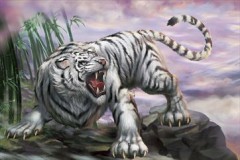 |
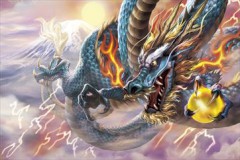 |
White tiger of the west - Blue dragon of the east
The panel above is made from two separate puzzles by the Chinese artist Song Qijin: White cloud tiger and Blue thunder dragon listed separately below. You can also combine these two vertically.
See also the matching Tiger and Dragon puzzles by Kayomi
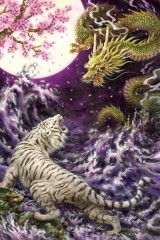 © Harai Kayomi / Studio Oz 2016: Moonlit tiger and dragon (Kayomi)Traditional rivals, tiger and dragon face off under a full moon masked only by a sprig of cherry blossom. No biographical details available. She signs her given name Kayomi in Roman letters.
 In stock In stockAn Epoch puzzle: 2016 pieces; 500 x 750 mm (20" x 30") Code: E23087 (23-087 on package) Retail price ¥3000 (approx. US$20.69 €19.11 £16.04) All about ordering (please read first)
|
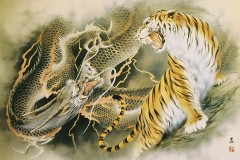 © Ozuma Kaname 1000: Dragon vs. tiger (Kaname)The tiger, symbol of fire, and the dragon, symbol of water, are often portrayed as adversaries, representing the heaven-earth or ying-yang dichotomy. Note that the tiger is quite naturalistic, whereas the dragon is an entirely mythical beast, and more like a snake with legs and horns than the giant lizard form of Western dragon.  This puzzle is also available in 2000 pieces (code A20047). The painter Ozuma Kaname was born in 1939, in Niigata. He studied traditional Japanese art, and his pictures are generally based on traditional themes. Ozuma is his family name: he signs paintings with the single character of his given name only.  In stock In stockAn Appleone puzzle: 1000 pieces; 750 x 500 mm (30" x 20") Code: A10311 (1000-311 on package) Retail price ¥3000 (approx. US$20.69 €19.11 £16.04) All about ordering (please read first)
|
Related pages
- Tigers - the auspicious white tiger, and the ferocious yellow one
- More traditional themes - Red Fuji, and lucky flowers, fish, animals and birds
- Gods - features sets of seven, four and two
- Lucky! - the animals of the Chinese calendar cycle
- Kaname - painter of traditional lucky themes, particularly various animals

 This puzzle has smaller pieces than the standard size.
This puzzle has smaller pieces than the standard size.